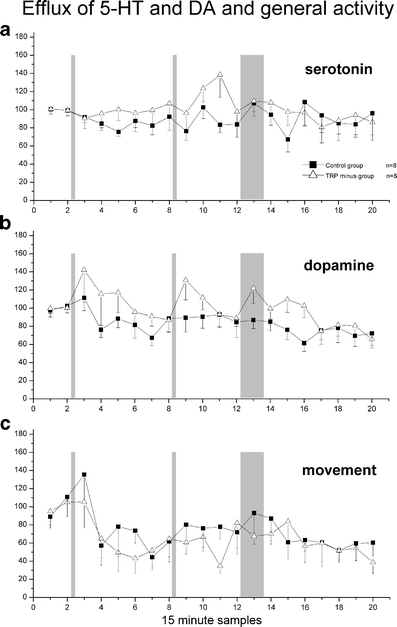Lack of evidence for reduced prefrontal cortical serotonin and dopamine efflux after acute tryptophan depletion
- PMID: 17713760
- PMCID: PMC2080347
- DOI: 10.1007/s00213-007-0908-7
Lack of evidence for reduced prefrontal cortical serotonin and dopamine efflux after acute tryptophan depletion
Abstract
Rationale: Acute tryptophan depletion (ATD) is a widely used method to study the role of serotonin (5-HT) in affect and cognition. ATD results in a strong but transient decrease in plasma tryptophan and central 5-HT synthesis and availability. Although its use is widespread, the evidence that the numerous functional effects of ATD are caused by actual changes in 5-HT neuronal release is not very strong. Thus far, decreases in 5-HT efflux (thought to reflect synaptic release) were only reported after chronic tryptophan depletion or when ATD was combined with blockade of 5-HT reuptake.
Objective: With the current experiment, we aimed to study the validity of the method of ATD by measuring the extent to which it reduces the efflux of 5-HT (and dopamine) in the prefrontal cortex in the absence of reuptake blockage.
Materials and methods: We simultaneously measured in freely moving animals plasma tryptophan via a catheter in the jugular vein and 5-HT and DA efflux in the medial prefrontal cortex through microdialysis after ATD treatment.
Results: ATD reduced plasma tryptophan to less than 30% of control, without affecting 5-HT or DA efflux in the prefrontal cortex, indicating that even strong reductions of plasma tryptophan do not necessarily result in decreases in central 5-HT efflux.
Conclusion: The present experiment showed that reductions in plasma tryptophan, similar to values associated with behavioural effects, do not necessarily reduce 5-HT efflux and suggest that the cognitive and behavioural effects of ATD may not be (exclusively) due to alterations in 5-HT release.
Figures


Similar articles
-
Effects of acute and chronic buspirone on impulsive choice and efflux of 5-HT and dopamine in hippocampus, nucleus accumbens and prefrontal cortex.Psychopharmacology (Berl). 2004 Apr;173(1-2):175-85. doi: 10.1007/s00213-003-1726-1. Epub 2004 Jan 15. Psychopharmacology (Berl). 2004. PMID: 14726995
-
Acute tryptophan depletion in rats alters the relationship between cerebral blood flow and glucose metabolism independent of central serotonin.Neuroscience. 2009 Oct 6;163(2):683-94. doi: 10.1016/j.neuroscience.2009.06.063. Epub 2009 Jul 3. Neuroscience. 2009. PMID: 19580853
-
Serial reversal learning and acute tryptophan depletion.Behav Brain Res. 2008 Jan 10;186(1):23-31. doi: 10.1016/j.bbr.2007.07.017. Epub 2007 Jul 20. Behav Brain Res. 2008. PMID: 17714800
-
Mechanism of acute tryptophan depletion: is it only serotonin?Mol Psychiatry. 2011 Jul;16(7):695-713. doi: 10.1038/mp.2011.9. Epub 2011 Feb 22. Mol Psychiatry. 2011. PMID: 21339754 Review.
-
The effects of acute tryptophan depletion on brain activation during cognition and emotional processing in healthy volunteers.Curr Pharm Des. 2010;16(18):1998-2011. doi: 10.2174/138161210791293060. Curr Pharm Des. 2010. PMID: 20370668 Review.
Cited by
-
CNTRICS final task selection: long-term memory.Schizophr Bull. 2009 Jan;35(1):197-212. doi: 10.1093/schbul/sbn134. Epub 2008 Oct 16. Schizophr Bull. 2009. PMID: 18927344 Free PMC article. Review.
-
Serotonin and migraine: a reconsideration of the central theory.J Headache Pain. 2008 Oct;9(5):267-76. doi: 10.1007/s10194-008-0058-2. Epub 2008 Jul 31. J Headache Pain. 2008. PMID: 18668197 Free PMC article. Review.
-
Serotonin and depression-an alternative interpretation of the data in Moncrieff et al.Mol Psychiatry. 2023 Aug;28(8):3158-3159. doi: 10.1038/s41380-023-02090-3. Epub 2023 Jun 16. Mol Psychiatry. 2023. PMID: 37322060 No abstract available.
-
Effects of acute tryptophan depletion on brain serotonin function and concentrations of dopamine and norepinephrine in C57BL/6J and BALB/cJ mice.PLoS One. 2012;7(5):e35916. doi: 10.1371/journal.pone.0035916. Epub 2012 May 21. PLoS One. 2012. PMID: 22629305 Free PMC article.
-
5-HT modulation by acute tryptophan depletion of human instrumental contingency judgements.Psychopharmacology (Berl). 2011 Feb;213(2-3):615-23. doi: 10.1007/s00213-010-1934-4. Epub 2010 Jul 15. Psychopharmacology (Berl). 2011. PMID: 20631992 Free PMC article.
References
-
- {'text': '', 'ref_index': 1, 'ids': [{'type': 'DOI', 'value': '10.1016/j.pharmthera.2006.08.004', 'is_inner': False, 'url': 'https://doi.org/10.1016/j.pharmthera.2006.08.004'}, {'type': 'PMC', 'value': 'PMC2562467', 'is_inner': False, 'url': 'https://pmc.ncbi.nlm.nih.gov/articles/PMC2562467/'}, {'type': 'PubMed', 'value': '17049611', 'is_inner': True, 'url': 'https://pubmed.ncbi.nlm.nih.gov/17049611/'}]}
- Alex KD, Pehek EA (2007) Pharmacologic mechanisms of serotonin regulation of dopamine neurotransmission. Pharmacol Ther 113:296–320 - PMC - PubMed
-
- {'text': '', 'ref_index': 1, 'ids': [{'type': 'DOI', 'value': '10.1007/s00213-006-0444-x', 'is_inner': False, 'url': 'https://doi.org/10.1007/s00213-006-0444-x'}, {'type': 'PubMed', 'value': '16823591', 'is_inner': True, 'url': 'https://pubmed.ncbi.nlm.nih.gov/16823591/'}]}
- Allen PP, Cleare AJ, Lee F, Fusar-Poli P, Tunstall N, Fu, CHY, Brammer MJ, McGuire PK (2006) Effect of acute tryptophan depletion on pre-frontal engagement. Psychopharmacology (Berl) 187:486–497 - PubMed
-
- {'text': '', 'ref_index': 1, 'ids': [{'type': 'DOI', 'value': '10.1111/j.1471-4159.1981.tb06306.x', 'is_inner': False, 'url': 'https://doi.org/10.1111/j.1471-4159.1981.tb06306.x'}, {'type': 'PubMed', 'value': '7334367', 'is_inner': True, 'url': 'https://pubmed.ncbi.nlm.nih.gov/7334367/'}]}
- Ashley VM, Curzon G (1981) Effects of long-term low dietary tryptophan intake on determinants of 5-hydroxytryptamine metabolism in the brains of young rats. J Neurochem 37:1385–1393 - PubMed
-
- {'text': '', 'ref_index': 1, 'ids': [{'type': 'PubMed', 'value': '8764594', 'is_inner': True, 'url': 'https://pubmed.ncbi.nlm.nih.gov/8764594/'}]}
- Bel N, Artigas F (1996) Reduction of serotonergic function in rat brain by tryptophan depletion: effects in control and fluvoxamine-treated rats. J Neurochem 67:669–676 - PubMed
-
- {'text': '', 'ref_index': 1, 'ids': [{'type': 'DOI', 'value': '10.1016/0024-3205(74)90440-8', 'is_inner': False, 'url': 'https://doi.org/10.1016/0024-3205(74)90440-8'}, {'type': 'PubMed', 'value': '4823644', 'is_inner': True, 'url': 'https://pubmed.ncbi.nlm.nih.gov/4823644/'}]}
- Biggio G, Fadda F, Fanni P, Tagliamonte A, Gessa GL (1974) Rapid depletion of serum tryptophan, brain tryptophan, serotonin and 5-hydroxyindoleacetic acid by a tryptophan-free diet. Life Sci 14:1321–1329 - PubMed
Publication types
MeSH terms
Substances
LinkOut - more resources
Full Text Sources
Research Materials

